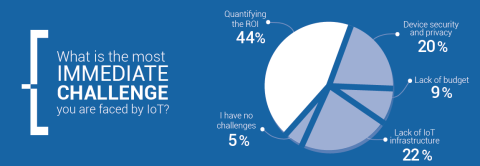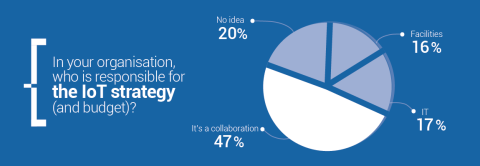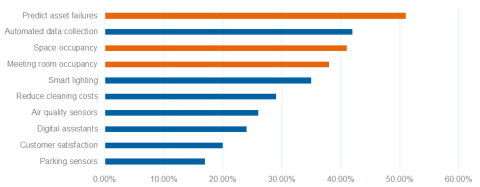As my colleagues have previously discussed, the most immediate challenge stopping facility managers from moving forward with an IoT project is quantifying the ROI or determining practical use-cases. Last month on 14 March, Planon hosted a webinar specifically addressing practical use-cases of the Internet of Things and Smart Buildings.
The idea behind this was to take these industry buzzwords and make them tangible, with a business case to justify their use. During this webinar, we also asked a few questions to see how facility managers view the topic of IoT. The first was to confirm the challenges they are facing.

How organisations approach IoT projects is also influenced by who within the organisation is primarily responsible for the project. Based on responses from webinar attendees, it was reassuring to see that most organisations have an effective collaboration between the facilities and IT departments.

Top three smart building related use cases
However, the primary focus of the webinar was to discuss practical use-cases to help organisations get started. To focus on the most interesting ones, we asked people who registered for the webinar to select the top three smart building related use-cases they were interested in hearing about. The list included these options:
- Improve meeting room occupancy using sensor technology
- Create a healthier workplace with air quality sensors
- Increase building performance by using sensors to predict asset failures
- Reduce cleaning costs by measuring user behaviour
- Improve customer satisfaction through feedback buttons
- Gain insight into real-time space occupancy using desk sensors
- Enhance customer experience with digital assistants, such as Amazon Alexa, for making FM requests
- Improve the employee experience with smart lighting or preferred temperatures
- Improve data quality with automated data collection by using sensors for energy meters, mouse traps, or other devices
- Optimise parking space and enhance your guests’ parking experience using parking sensors
Based on more than 200 responses received before 20 February, we selected the top three use-cases at the time to discuss in the webinar (highlighted below in orange). We continued to get feedback and ultimately got more than 440 responses globally to this poll with the final results shown here.

The top responses seem to focus on cost savings and operating efficiency uses for the Internet of Things, such as predicting asset failures, automating data collection, and improving space utilisation. However, the lowest interest is in the use-cases connected to end-users of a building. Improving customer satisfaction, creating a healthier workplace, and improving the visitor experience were of interest to less than a quarter of those who responded, although improving the employee experience with smart lighting or preferred temperatures got some significant interest.
Customer experience providing value
Despite this focus on cost savings, Planon and other industry leaders believe that customer experience will benefit from the Internet of Things. As one commenter on a Planon LinkedIn discussion observed, “So far, saving costs, space and energy seems to be the main focus [of IoT]. Nothing wrong with that. However, I believe far bigger benefits and returns are yet to come once we make the technology and data work for individual users. Providing them with feedback to support healthy working behaviours, for instance.”
What direction do you see IoT going? What do you believe drives this current focus on cost savings? It could be that it is easier to justify the investment in Smart Buildings when you can define the exact amount saved through space planning. Personally, I look forward to a future where these technologies are used to create more personalised and healthy workplaces.
